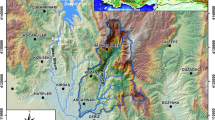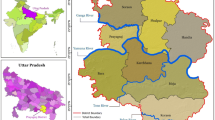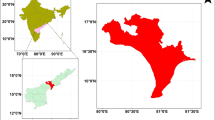Abstract
This study investigated the physiographic as well as meteorological characteristics of the Great Kwa River Basin (GKRB), with the following objectives: to assess the influence of the drainage characteristics of the GKRB to flash flooding, to produce a composite flash flood risk map of the GKRB using analytical hierarchy process (AHP) and to proffer flash flooding mitigation and management strategies for the GKRB. The flash flooding indicators evaluated were as follows: rainfall, absolute height, slope, distance from flow path, soil, land use, and land cover. The various input variables were analyzed using Quantum Geographic Information System (QGIS) software while the drainage characteristics were extracted using the Soil and Water Assessment Tool (SWAT). The weights of the various criteria were determined using the AHP. The weighted linear combination method was adopted for the determination of the composite flash flood hazard index. The composite flash flood index map was prepared with three categories: high (≥ 0.4), moderate (0.3–0.4), low (≤ 0.3) flash flood hazard areas. The results revealed that the GKRB has an above average potential to flash flooding considering the proportion of order 1 streams to all the stream orders within the drainage network. The composite flood risk map revealed that the upper and middle catchments are prone to moderate-to-high flash flooding risks while a low-to-moderate potentiality to flash flooding in the lower catchment was obtained. The understanding of the roles of the flash flooding indicators provides useful information for the effective management of the flooding hazard for the GKRB.

Source: Author







Source: Author

Similar content being viewed by others
Data Availability
The data and materials are available on request and can be obtained from the first author.
Code Availability
Not applicable.
References
Adnan MSG, Dewan A, Zannat KE, Abdullah AYM (2019) The use of watershed geomorphic data in flash flood susceptibility zoning: a case study of the Karnaphuli and Sangu river basins of Bangladesh. Nat Hazards 99(1):425–448
Alam A, Bhat MS, Farooq H, Ahmad B, Ahmad S, Sheikh AH (2018) Flood risk assessment of Srinagar city in Jammu and Kashmir, India. Int J Disaster Resilience Built Environ 9(2):114–129
Altın TB, Altın BN (2011) Drainage morphometry and its influence on landforms in volcanic terrain, Central Anatolia, Turkey. Procedia Soc Behav Sci 19:732–740
Ammerman AJ, Cavalli-Sforza LL (2014) The Neolithic transition and the genetics of populations in Europe (Vol. 836). Princeton University Press.
Baumgardner RW (1987) Morphometric studies of subhumid and semiarid drainage basins. Bureau of Economic Geology, University of Texas at Austin, Texas panhandle and Northeastern New Mexico
Berendes DM, Leon JS, Kirby AE, Clennon JA, Raj SJ, Yakubu H, Robb KA, Kartikeyan A, Hemavathy P, Gunasekaran A (2019) Associations between open drain flooding and pediatric enteric infections in the MAL-ED cohort in a low-income, urban neighborhood in Vellore India. BMC Public Health 19(1):1–11
Bhandari S, Jobe A, Thakur B, Kalra A, Ahmad S (2018) Flood damage reduction in urban areas with use of low impact development designs. World Environmental and Water Resources Congress,
Bhat MS, Alam A, Ahmad S, Farooq H, Ahmad B (2019) Flood hazard assessment of upper Jhelum basin using morphometric parameters. Environmental Earth Sciences 78(2):1–17
Birkland TA, Burby RJ, Conrad D, Cortner H, Michener WK (2003) River ecology and flood hazard mitigation. Nat Hazard Rev 4(1):46–54
Blöschl G, Ardoin-Bardin S, Bonell M, Dorninger M, Goodrich D, Gutknecht D, Matamoros D, Merz B, Shand P, Szolgay J (2007) At what scales do climate variability and land cover change impact on flooding and low flows? Hydrol Process 21(9):1241–1247
Calder IR, Aylward B (2006) Forest and floods: Moving to an evidence-based approach to watershed and integrated flood management. Water International 31(1):87–99
Chitra C, Alaguraja P, Ganeshkumari K, Yuvaraj D, Manivel M (2011) Watershed characteristics of Kundah sub basin using remote sensing and GIS techniques. Int J geomatics geosci 2(1):311
Cirella GT, Iyalomhe FO (2018) Flooding conceptual review: sustainability-focalized best practices in Nigeria. Appl Sci 8(9):1558
Clement AR (2012) Causes of seasonal flooding in flood plains: a case of Makurdi, Northern Nigeria. Int J Environ Stud 69(6):904–912
Cologna V, Bark RH, Paavola J (2017) Flood risk perceptions and the UK media: moving beyond “once in a lifetime” to “Be Prepared” reporting. Clim Risk Manag 17:1–10
Creutzberg D (1986) Micromorphological characteristics of Nitosols.
Danáčová M, Földes G, Labat MM, Kohnová S, Hlavčová K (2020) Estimating the effect of deforestation on runoff in small mountainous basins in Slovakia. Water 12(11):3113
Dingman SL (2015) Physical hydrology. Waveland press.
Eccles R, Zhang H, Hamilton D (2019) A review of the effects of climate change on riverine flooding in subtropical and tropical regions. J Water Clim Chang 10(4):687–707
Echendu AJ (2020) The impact of flooding on Nigeria’s sustainable development goals (SDGs). Ecosyst Health Sustain 6(1):1791735
Echendu AJ (2021) Relationship between urban planning and flooding in Port Harcourt city, Nigeria; insights from planning professionals. J Flood Risk Manag 14(2):e12693
Ephraim BE, Ajayi IO (2014) Geoenvironmental assessments of heavy metals in surface sediments from some creeks of the Great Kwa River, Southeastern Nigeria. J Environ Earth Sci 4(21):2224–3216
FAO U (1977) Soil Map of the world, 6. Africa. In: UNESCO, Paris.
Fleming G (2002) How can we learn to live with rivers? The findings of the Institution of Civil Engineers Presidential Commission on flood-risk management. Philosophical Transactions of the Royal Society of London Series A: Mathematical, Physical and Engineering Sciences 360(1796):1527–1530
Freni G, Liuzzo L (2019) Effectiveness of rainwater harvesting systems for flood reduction in residential urban areas. Water 11(7):1389
Gabale SM, Pawar NR (2015) Quantitative morphometric analysis of AmbilOdha (rivulet) in Pune, Maharashtra, India. IOSR Journal of Environmental Science, Toxicology and Food Technology 9(7):41–48
Gholami V (2013) The influence of deforestation on runoff generation and soil erosion (Case study: Kasilian Watershed). J For Sci 59(7):272–278
Ghosh A, Kar SK (2018) Application of analytical hierarchy process (AHP) for flood risk assessment: a case study in Malda district of West Bengal, India. Natural hazards 94(1):349–368
Gompf K, Traverso M, Hetterich J (2021) Using analytical hierarchy process (AHP) to introduce weights to social life cycle assessment of mobility services. Sustainability 13(3):1258
Gopalakrishna G, Kantharaj T, Balasubramanian A (2004) Morphometric analysis of Yagachi and Hemavathi River basins around Alur Taluk, Hassan District, Karnataka, India. J Appl Hydrol 17:9–17
Howard AD (1990) Role of hypsometry and planform in basin hydrologic response. Hydrol Process 4(4):373–385
Ikani DI (2016) Assessment of the impact of flooding on Dagiri Community in Gwagwalada Area Council, FCT, Nigeria (Federal University of Technology, Minna (Center for Disaster Risk …].
Jamali B, Bach PM, Deletic A (2020) Rainwater harvesting for urban flood management–An integrated modelling framework. Water Res 171:115372
Jimme MA, Bashir A, Adebayo AA (2016) Spatial distribution pattern and terrain analysis of urban flash floods and inundated areas in Maiduguri Metropolis, Borno State, Northeast, Nigeria. J Geogr Inf Syst 8(01):108
Kundzewicz ZW, Kanae S, Seneviratne SI, Handmer J, Nicholls N, Peduzzi P, Mechler R, Bouwer LM, Arnell N, Mach K (2014) Flood risk and climate change: global and regional perspectives. Hydrol Sci J 59(1):1–28
Mahapatra M, Ramakrishnan R, Rajawat A (2015) Coastal vulnerability assessment using analytical hierarchical process for South Gujarat coast, India. Natural hazards 76(1):139–159
Martínez-Mena M, Albaladejo J, Castillo V (1998) Factors influencing surface runoff generation in a Mediterranean semi-arid environment: Chicamo watershed, SE Spain. Hydrol Processes 12(5):741–754
Messner F, Meyer V (2006) Flood damage, vulnerability and risk perception–challenges for flood damage research. In Flood risk management: hazards, vulnerability and mitigation measures (pp. 149–167). Springer.
Mondal S, Maiti R (2013) Integrating the analytical hierarchy process (AHP) and the frequency ratio (FR) model in landslide susceptibility mapping of Shiv-khola watershed, Darjeeling Himalaya. Int J Disaster Risk Sci 4(4):200–212
Mumeka A (1986) Effect of deforestation and subsistence agriculture on runoff of the Kafue River headwaters, Zambia. Hydrol Sci J 31(4):543–554
Nigerian Bureau of Statistics (2011) Annual abstracts of statistics. Nigeria: National Bureau of Statistics.
Nigeria Hydrological Services Agency (2021) 2021 Annual Flood Outlook (AFO).
Nnaji CC, Mama NC (2014) Preliminary assessment of rainwater harvesting potential in Nigeria: focus on flood mitigation and domestic water supply. Water Resour Manage 28(7):1907–1920
Oates JF (2004) Africa’s Gulf of Guinea forests: biodiversity patterns and conservation implications. Adv Appl Biodivers Sci 6:1–90
Odunuga S, Oyebande L, Omojola A (2012) Social-economic indicators and public perception on urban flooding in Lagos, Nigeria. Special Publication of the Nigerian Association of Hydrological Sciences, 82–96.
Ogarekpe NM, Obio EA, Tenebe IT, Emenike PGC, Nnaji CC (2020) Flood vulnerability assessment of the upper Cross River basin using morphometric analysis. Geomat Nat Haz Risk 11(1):1378–1403
Ogarekpe NM, Obio EA, Tenebe IT, Emenike PGC, Nnaji CC (2020) A data for Flood vulnerability assessment of the upper Cross River basin using morphometric analysis. Data Brief 30:105344
Parry JA, Ganaie SA, Bhat MS (2018) GIS based land suitability analysis using AHP model for urban services planning in Srinagar and Jammu urban centers of J&K, India. J Urban Manag 7(2):46–56
Pratomo RA (2015) Flash Flood behaviour on a small Caribbean island: a comparison of two watersheds in Grenada. University of Twente Faculty of Geo-Information and Earth Observation (ITC).
Qi H, Qi P, Altinakar M (2013) GIS-based spatial Monte Carlo analysis for integrated flood management with two dimensional flood simulation. Water Resour Manage 27(10):3631–3645
Rahman M, Ningsheng C, Islam MM, Dewan A, Iqbal J, Washakh RMA, Shufeng T (2019) Flood susceptibility assessment in Bangladesh using machine learning and multi-criteria decision analysis. Earth Systems and Environment 3(3):585–601
Razandi Y, Pourghasemi HR, Neisani NS, Rahmati O (2015) Application of analytical hierarchy process, frequency ratio, and certainty factor models for groundwater potential mapping using GIS. Earth Sci Inf 8(4):867–883
Rodriguez‐Iturbe I, Muneepeerakul R, Bertuzzo E, Levin SA, Rinaldo A (2009) River networks as ecological corridors: A complex systems perspective for integrating hydrologic, geomorphologic, and ecologic dynamics. Water Resour Res, 45(1).
Saaty TL (1977) A scaling method for priorities in hierarchical structures. J Math Psychol 15(3):234–281
Saha A, Roy R (2021) An integrated approach to identify suitable areas for built-up development using GIS-based multi-criteria analysis and AHP in Siliguri planning area, India. SN Applied Sciences 3(4):1–17
Schumacher RS (2017) Heavy rainfall and flash flooding. In Oxford Research Encyclopedia of Natural Hazard Science.
Sreedevi P, Owais S, Khan H, Ahmed S (2009) Morphometric analysis of a watershed of South India using SRTM data and GIS. J Geol Soc India 73(4):543–552
Stefanidis S, Stathis D (2013) Assessment of flood hazard based on natural and anthropogenic factors using analytic hierarchy process (AHP). Nat Hazards 68(2):569–585
Strahler AN (1952) Dynamic basis of geomorphology. Geol Soc Am Bull 63(9):923–938
Suriya S, Mudgal B (2012) Impact of urbanization on flooding: the Thirusoolam sub watershed–A case study. J Hydrol 412:210–219
Tabari H (2020) Climate change impact on flood and extreme precipitation increases with water availability. Sci Rep 10(1):1–10
Tamagnone P, Comino E, Rosso M (2020) Rainwater harvesting techniques as an adaptation strategy for flood mitigation. J Hydrol 586:124880
Tassew BG, Belete MA, Miegel K (2021) Assessment and analysis of morphometric characteristics of Lake Tana sub-basin, Upper Blue Nile Basin, Ethiopia. Int J River Basin Manag, 1–15.
Tempa K (2022) District flood vulnerability assessment using analytic hierarchy process (AHP) with historical flood events in Bhutan. PLoS ONE 17(6):e0270467
Teston A, Geraldi MS, Colasio BM, Ghisi E (2018) Rainwater harvesting in buildings in Brazil: A literature review. Water 10(4):471
Ugwuibe CO, Onah FN, Olise CN (2021) Flood Disasters in Aba North Local Government Area of Abia State, Nigeria: Policy Options. In Economic Effects of Natural Disasters (pp. 373–380). Elsevier.
Ukpong A, Ikediasor C, Emeka C, Emeka V Tidal Influence on Foraminifera distribution in a typical Mesotidal River; A Case Study of the Great Kwa River, Southeastern Nigeria.
Waikar M, Nilawar AP (2014) Morphometric analysis of a drainage basin using geographical information system: a case study. Int J Multidiscip Curr Res 2(2014):179–184
Wedley WC (1990) Combining qualitative and quantitative factors—an analytic hierarchy approach. Socioecon Plann Sci 24(1):57–64
Weldu, W. G., & Deribew, I. A. (2016). Identification of potential sites for housing development using GIS based multi-criteria evaluation in Dire Dawa City, Ethiopia. Int J Sci: Basic Appl Res, 34–49.
Youssef AM, Pradhan B, Hassan AM (2011) Flash flood risk estimation along the St. Katherine road, southern Sinai, Egypt using GIS based morphometry and satellite imagery. Environ Earth Sci 62(3):611–623
Zambrano L, Pacheco-Muñoz R, Fernández T (2018) Influence of solid waste and topography on urban floods: The case of Mexico City. Ambio 47(7):771–780
Zhao B, Lei H, Yang D, Yang S, Santisirisomboon J (2022) Runoff and sediment response to deforestation in a large Southeast Asian monsoon watershed. J Hydrol 606:127432
Author information
Authors and Affiliations
Contributions
The study was conceptualized by NO. The data collection and analysis were carried out by NO. NO, CN, and ME wrote the paper.
Corresponding author
Ethics declarations
Competing Interests
The authors declare no competing interests.
Consent to Participate
Not applicable.
Consent for Publication
Not applicable.
Conflict of Interest
The authors declare no competing interests.
Additional information
Publisher’s Note
Springer Nature remains neutral with regard to jurisdictional claims in published maps and institutional affiliations.
Rights and permissions
Springer Nature or its licensor holds exclusive rights to this article under a publishing agreement with the author(s) or other rightsholder(s); author self-archiving of the accepted manuscript version of this article is solely governed by the terms of such publishing agreement and applicable law.
About this article
Cite this article
Ogarekpe, N.M., Nnaji, C.C. & Ekpenyong, M.G. Flash Flood Risk Assessment of the Great Kwa River Basin Using Analytical Hierarchy Process. Water Conserv Sci Eng 7, 599–611 (2022). https://doi.org/10.1007/s41101-022-00167-8
Received:
Revised:
Accepted:
Published:
Issue Date:
DOI: https://doi.org/10.1007/s41101-022-00167-8




